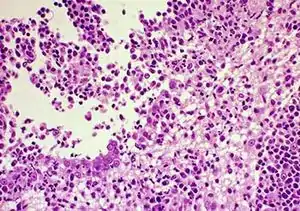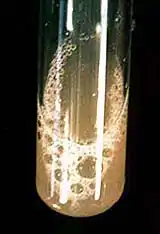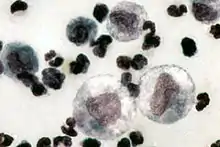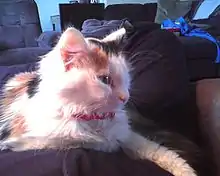Feline infectious peritonitis
Feline infectious peritonitis (FIP) is the name given to a common and aberrant immune response to infection with feline coronavirus (FCoV).[2]
| Feline infectious peritonitis | |
|---|---|
 | |
| FIP-infected kidney showing inflammatory response | |
| Specialty | Infectious disease |
| Symptoms | Initial phase: common cold-like symptoms.
Later on: ataxia, muscle weakness, dysphagia. End phase: shortness of breath, urinary incontinence, paralysis. |
| Usual onset | Can take up to a year for symptoms to appear after exposure to virus |
| Duration | 1-month or less average life expectancy after diagnosis, especially in kittens |
| Causes | Mutation of feline coronavirus |
| Prevention | Keeping cats indoor to prevent the spread of feline coronavirus |
| Treatment | None approved, some treatments show promise in early trials[1] |
| Prognosis | Fatal |
| Frequency | Common |
The virus and pathogenesis of FIP
FCoV is a virus of the gastrointestinal tract. Most infections are either asymptomatic or cause diarrhea, especially in kittens, as maternally derived antibody wanes at between 5 and 7 weeks of age. The virus is a mutation of feline enteric coronavirus (FECV). From the gut, the virus very briefly undergoes a systemic phase,[3] before returning to the gut where it is shed in the feces.
The pathogenesis of FIP is complex. There is a general consensus that FIPVs arise from mutations enabling them to enter or replicate more successfully in monocytes (a type of white blood cell). However, many aspects of virus–host interactions affecting the disease remain uncertain, such as the factors that influence disease form (wet or dry), outcome (death or resistance), and host susceptibility.[4]
Virus transmission
FCoV is common in places where large groups of cats are housed together indoors (e.g. breeding catteries, animal shelters, etc.). The virus is shed in feces and cats become infected by ingesting or inhaling the virus, usually by sharing cat litter trays, or by the use of contaminated litter scoops or brushes transmitting infected microscopic cat litter particles to uninfected kittens and cats.[5] FCoV can also be transmitted through different bodily fluids. The virus is easily spread through direct contact between cats. The most common form of spreading is through saliva, as most multiple cat homes share food and water dishes.[6] Another major form of spreading is grooming or fighting. When an infected cat grooms a healthy cat, they leave their contaminated saliva on the fur. Later, when the healthy cat goes to groom themselves, they ingest the contaminated saliva and then become infected.[7]
Clinical signs

There are two main forms of FIP: effusive (wet) and non-effusive (dry). While both types are fatal, the effusive form is more common (60–70% of all cases) and progresses more rapidly than the non-effusive form.
Effusive (wet) FIP
The hallmark clinical sign of effusive FIP is the accumulation of fluid within the abdomen or chest, which can cause breathing difficulties. Other symptoms include lack of appetite, fever, weight loss, jaundice, and diarrhea.
Non-effusive (dry) FIP
Dry FIP will also present with lack of appetite, fever, jaundice, diarrhea, and weight loss, but there will not be an accumulation of fluid. Typically a cat with dry FIP will show ocular or neurological signs. For example, the cat may develop difficulty in standing up or walking, becoming functionally paralyzed over time. Loss of vision is another possible outcome of the disease.
Diagnosis

Diagnosing effusive FIP
Diagnosis of the effusive form of the disease has become more straightforward in recent years. Detection of viral RNA in a sample of the effusion (liquid drained from body), such as by reverse transcription polymerase chain reaction (RT-PCR) is diagnostic of effusive FIP.[8][9][10] However, that does require that a sample be sent to an external veterinary laboratory. Within the veterinary hospital there are a number of tests which can rule out a diagnosis of effusive FIP within minutes:
- Measure the total protein in the effusion: if it is less than 35g/L, FIP is extremely unlikely.
- Measure the albumin to globulin ratio in the effusion: if it is over 0.8, FIP is ruled out; if it is less than 0.4, FIP is a possible—but not certain—diagnosis.[11]
- Examine the cells in the effusion: if they are predominantly lymphocytes (a type of white blood cell), then FIP is excluded as a diagnosis.
Diagnosing non-effusive FIP
Non-effusive FIP is more difficult to diagnose than effusive FIP because the clinical signs tend to be more vague and varied: the list of differential diagnoses is therefore much longer. Non-effusive FIP diagnosis should be considered when the following criteria are met:[11]
- History: the cat is young (under 2 years old) and purebred: over 70% of cases of FIP are in pedigree kittens.
- History: the cat experienced stress such as recent neutering or vaccination[12]
- History: the cat had an opportunity to become infected with FCoV, such as originating in a breeding or rescue cattery, or the recent introduction of a purebred kitten or cat into the household.
- Clinical signs: the cat has become anorexic or is eating less than usual; has lost weight or failed to gain weight; has a fever of unknown origin; intra-ocular signs; jaundice.[13]
- Biochemistry: hypergammaglobulinaemia; raised bilirubin without liver enzymes being raised.
- Hematology: lymphopenia; non-regenerative—usually mild—anaemia.
- Serology: the cat has a high antibody titre to FCoV: this parameter should be used with caution, because of the high prevalence of FCoV in breeding and rescue catteries.
Non-effusive FIP can be ruled out as a diagnosis if the cat is seronegative, provided the antibody test has excellent sensitivity. In a study which compared various commercially available in-house FCoV antibody tests,[14] the FCoV Immunocomb (Biogal) was 100% sensitive; the Speed F-Corona rapid immunochromatographic (RIM) test (Virbac) was 92.4% sensitive and the FASTest feline infectious peritonitis (MegaCor Diagnostik) RIM test was 84.6% sensitive.
Treatment

Because FIP is an immune-mediated disease, treatment falls into two categories: direct action against the virus itself and modulation of the immune response.
Immunostimulants
Immunostimulants are drugs that make the immune system more active against the virus. The most common drugs of this class for treating FIP are either recombinant feline interferon omega (Virbagen Omega, Virbac) or human interferon alfa-2b. Since the human version ends up being targeted by the immune system for being a foreign antigen, the feline version feline interferon is more effective.[15]
An experimental polyprenyl immunostimulant (PI) is manufactured by Sass and Sass and tested by Dr. Al Legendre, who described survival over 1 year in three cats diagnosed with FIP and treated with the medicine.[16] In a subsequent field study of 60 cats with non-effusive FIP treated with PI, 52 cats (87%) died before 200 days, but eight cats survived over 200 days from the start of PI treatment for and four of those survived beyond 300 days.[17]
Antivirals
Antivirals (in the narrow sense) act by interfering with the enzymes or other biological processes in the FIP virus.
An experimental drug called GS-441524 was used in a field experiment of 31 cats. After 25 days, five cats had died, eight had been cured and subsequently relapsed, and 18 had been cured without any subsequent relapses. The eight who relapsed were treated again, some with higher doses. Of these eight, one died and seven were cured, meaning that 25 of the 31 cats were ultimately cured of FIP. Although the drug is not yet (as of 2019) commercially available in the United States, this study is considered very promising and may lead to commercially available medication for the treatment of FIP.[18] GS-441524 is available at >99% purity commercially from research chemical suppliers such as Selleckchem,[19] MedKoo[20] and MedChemExpress.[21]
An experimental antiviral drug called GC376 was used in a field trial of 20 cats: 7 cats went into remission, and 13 cats responded initially but relapsed and were euthanized. This drug is not yet (as of 2017) commercially available.[22]
Anti-inflammatory drugs
It is generally recommended to use an anti-inflammatory drug against FIP.
Immunosuppressive drugs dampen the immune system, helping to reduce inflammation. The go-to immunosuppressive drug in FIP is prednisolone, a corticosteroid. There are no placebo-controlled trials showing prednisolone to be better than other anti-inflammatories.[23]
Prevention
Vaccination
There is no effective vaccine against FIPV. DNA vaccination with plasmids encoding FIPV proteins failed to produce immunity.[24] Rather, it was observed that antibodies to the FIPV spike protein exacerbate the disease.
Prevention
Kittens are protected from infection by maternally derived antibody until weaning, usually around 5–7 weeks of age; therefore, it is possible to prevent infection of kittens by removing them from sources of infection.[25] However, FCoV is a very contagious virus and such prevention does require rigorous hygiene.
In film
A 2018 film titled Aeris, by Paul Castro Jr. and Aly Miller, and starring Frank Deal, Arabella Oz and Betsy Aidem, is about a kitten born with FIP that is purchased from a pet store and the owners' twelve days with it.[26][27] The film received an award at the 2018 Garden State Film Festival in the Narrative Short category[28] and was a Gold Kahuna winner at the 2018 Honolulu Film Awards.[29]
See also
References
- "FIP drugs continue to show promise, while being sold on black market".
- Addie, D.; Belák, S.; Boucraut-Baralon, C.; Egberink, H.; Frymus, T.; Gruffydd-Jones, T.; Hartmann, K.; Hosie, M. J.; Lloret, A.; et al. (2009-07-11). "Feline infectious peritonitis. ABCD guidelines on prevention and management". Journal of Feline Medicine and Surgery. 11 (7): 594–604. doi:10.1016/j.jfms.2009.05.008. PMC 7129471. PMID 19481039.
- Porter, E.; Tasker, S.; Day, M. J.; Harley, R.; Kipar, A.; Siddell, S. G.; Helps, C. R. (2014-04-25). "Amino acid changes in the spike protein of feline coronavirus correlate with systemic spread of virus from the intestine and not with feline infectious peritonitis". Veterinary Research. BiomedCentral. 45 (1): 49. doi:10.1186/1297-9716-45-49. PMC 4006447. PMID 24767677.
- Pedersen, N. C. (August 2014). "An update on feline infectious peritonitis: virology and immunopathogenesis". The Veterinary Journal. 201 (2): 123–132. doi:10.1016/j.tvjl.2014.04.017. PMC 7110662. PMID 24837550.
- "How cats become infected with feline coronavirus: animation".
- "Feline Infectious Peritonitis (FIP) Transmission - Feline Infectious Peritonitis (FIP)". HealthCommunities. Retrieved 2018-11-02.
- "FIP | The Cat Community". The Cat Community. Retrieved 2018-11-02.
- Felten, S.; Leutenegger, C. M.; Balzer, H-J; Pantchev, N.; Matiasek, K.; Wess, G.; Egberink, H.; Hartmann, K. (2017-08-02). "Sensitivity and specificity of a real-time reverse transcriptase polymerase chain reaction detecting feline coronavirus mutations in effusion and serum/plasma of cats to diagnose feline infectious peritonitis". Veterinary Research. BiomedCentral. 13 (1): 228. doi:10.1186/s12917-017-1147-8. PMC 5541694. PMID 28768514.
- Doenges, S. J.; Weber, K.; Dorsch, R.; Fux, R.; Hartmann, K. (2017-04-01). "Comparison of real-time reverse transcriptase polymerase chain reaction of peripheral blood mononuclear cells, serum and cell-free body cavity effusion for the diagnosis of feline infectious peritonitis" (PDF). Journal of Feline Medicine and Surgery. 19 (4): 344–350. doi:10.1177/1098612X15625354. PMID 26787293. S2CID 7136727.
- Longstaff, L.; Porter, E.; Crossley, V. J.; Hayhow, S. E.; Helps, C. R.; Tasker, S. (2015-10-16). "Feline coronavirus quantitative reverse transcriptase polymerase chain reaction on effusion samples in cats with and without feline infectious peritonitis". Journal of Feline Medicine and Surgery. 19 (2): 240–245. doi:10.1177/1098612X15606957. PMID 26474594. S2CID 206692877.
- "Dr. Addie - What is FIP?". www.catvirus.com.
- Riemer, F.; Kuehner, K. A.; Ritz, S.; Sauter-Louis, C.; Hartmann, K. (2015-07-16). "Clinical and laboratory features of cats with feline infectious peritonitis – a retrospective study of 231 confirmed cases (2000–2010)". Journal of Feline Medicine and Surgery. 18 (4): 348–356. doi:10.1177/1098612X15586209. PMID 26185109. S2CID 206692653.
- Diane D. Addie (2013-04-19). Feline Infectious Peritonitis and Coronavirus: Everything a cat lover needs to know. ISBN 978-1480208971.
- Addie, D. D.; le Poder, S.; Burr, P.; Decaro, N.; Graham, E.; Hofmann-Lehmann, R.; Jarrett, O.; McDonald, M.; Meli, M. L. (2015-02-01). "Utility of feline coronavirus antibody tests". Journal of Feline Medicine and Surgery. 17 (2): 152–162. doi:10.1177/1098612X14538873. PMID 24966245. S2CID 21831168.
- Forney, Barbara. "Interferon Alpha-2B for Veterinary Use". Wedgewood Pharmacy.
- Legendre, A. M.; Bartges, J. W. (2009-08-01). "Effect of Polyprenyl Immunostimulant on the survival times of three cats with the dry form of feline infectious peritonitis". Journal of Feline Medicine and Surgery. 11 (8): 624–626. doi:10.1016/j.jfms.2008.12.002. PMC 7130077. PMID 19482534.
- Legendre, A. M.; Kuritz, T.; Galyon, G.; Baylor, V. M.; Heidel, R. E. (2017-02-14). "Polyprenyl Immunostimulant Treatment of Cats with Presumptive Non-Effusive Feline Infectious Peritonitis In a Field Study". Frontiers in Veterinary Science. 4: 7. doi:10.3389/fvets.2017.00007. PMC 5306384. PMID 28261584. S2CID 4835088.
- Pedersen, N. C.; Perron, M.; Bannasch, M.; Montgomery, E.; Murakami, E.; Liepnieks, M.; Liu, H. (2019-02-13). "Efficacy and safety of the nucleoside analog GS-441524 for treatment of cats with naturally occurring feline infectious peritonitis". Journal of Feline Medicine and Surgery. 21 (4): 271–281. doi:10.1177/1098612X19825701. PMC 6435921. PMID 30755068.
- https://www.selleckchem.com/products/gs-441524.html
- https://medkoo.com/products/27317
- https://www.medchemexpress.com/GS-441524.html
- Pedersen, N. C.; Kim, Y.; Liu, H.; Galasiti Kankanamalage, A. C.; Eckstrand, C.; Groutas, W. C.; Bannasch, M.; Meadows, J. M.; Chang, K. O. (2017-09-13). "Efficacy of a 3C-like protease inhibitor in treating various forms of acquired feline infectious peritonitis". Journal of Feline Medicine and Surgery. 20 (4): 378–392. doi:10.1177/1098612X17729626. PMC 5871025. PMID 28901812. S2CID 4595813.
- Hugo, TB; Heading, KL (January 2015). "Prolonged survival of a cat diagnosed with feline infectious peritonitis by immunohistochemistry". The Canadian veterinary journal / La revue veterinaire canadienne. 56 (1): 53–8. PMC 4266056. PMID 25565715.
- Glansbeek, H. L.; Haagmans, B. L.; Te Lintelo, E. G.; Egberink, H. F.; Duquesne, V.; Aubert, A.; Horzinek, M. C.; Rottier PJM (2002). "Adverse effects of feline IL-12 during DNA vaccination against feline infectious peritonitis virus". J Gen Virol. 83 (Pt 1): 1–10. doi:10.1099/0022-1317-83-1-1. PMID 11752695.
- Addie, D. D.; Jarrett, O. (1992-02-15). "A study of naturally occurring feline coronavirus infection in kittens". Veterinary Record. 130 (7): 133–137. doi:10.1136/vr.130.7.133. PMID 1313617. S2CID 10155484.
- "Aeris (2018)". Rotten Tomatoes.
- "The Story of Aeris: A Legacy Inspired by Love". The Purrington Post. Nov 30, 2016.
- "Garden State Film Festival 2018 Winners". New Jersey Stage. 2018-04-10.
- "2018 Winners, 2018 Gold Kahuna Winners". Honolulu Film Awards.
External links
- Feline Infectious Peritonitis and Coronavirus Website
- Why Do Cats Purr? Is It Good Or Bad? - Two Cat Freaks Blog
- Feline Infectious Peritonitis from vetinfo.com
- Research on Feline Infectious Peritonitis from University of Tennessee, College of Veterinary Medicine
- FIP: A 2012 Update
- FIP Informational Brochure from the Cornell Feline Health Center
- UC Davis Center for Companion Animal Health
- Animal Health Channel
- Feline Advisory Bureau
- FIP (Felipedia.org)